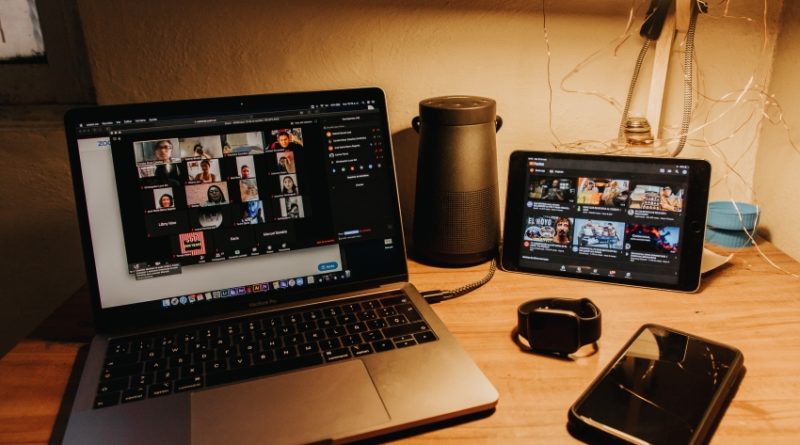5 Best Laptops For Teachers in 2024 (From $300)
Considering the fact that we have to:
- Browse the web to prepare lessons
- Use MS Office & Zoom
- Print assignments and exams for evaluations
- Make presentations and upload files
- Record Video lessons
The best laptop for teachers have:
- Big & High resolution display
- Enough memory for easy & fast multitasking
- Great & full sized keyboards (with numerial keypads).
- Efficiently placed WiFi Card of the latest protocol (for superb internet reception)
This rules most small laptops, chromebooks, convertibles.
It also rules any with low RAM and without FHD displays (found under 300).
I’d say you need to spend around 500 bucks on a decent laptop for teachers…
However…
You can go low and you can high.
But you will lose some cool features if you go low.
Recommended Laptop Specs For Teachers
Before we go over the 5 best laptops for teachers in 2024, let’s go over what specs to pick if you’re buying a laptop on your own. More details are in the last section. I
CPU
You want a MODERN INTEL CORE or RYZEN CPU.
By modern I simply mean a CPU released within the past 3 years. Some examples (in order of increasing performane for teaching & multitasking):
I’ve omitted Core i7 and Ryzen 7 CPUs because they’re too fast.
Core i5/Ryzen 5 CPUs offer the best performance/ratio. Whereas Core i3/Ryzen 3 make laptops very budget friendly.
RAM: 8GB
8GB RAM: it’s the bare minimum. You don’t need to worry about RAM generation (DDR4 or DDR5). The latter is faster though.
16GB RAM: Ideally, you want 16GB RAM for the most extreme multitasking situations. Dozens of tabs open + zoom + office + lots of school software will run fast . No need to buy 16GB RAM, its cheaper to buy 8GB then do the upgrade.
Display: High Resolution
Multitasking and working with software with lots of rows of data is much easier with more screen space.
FHD or QHD: Besides getting a large display, high resolution also gives you more screen space.
HD+ or HD: Found on cheap laptops, must be avoided. It will kill your productivity.
KeyBoard
You want: numberpad + backlit feature + bouncy keyboards.
It’s easy to check the first two but it’s hard to tell what’s a good bouncy keyboard. Most laptops have decent keyboards, just be sure to read reviews to avoid the bad ones.
Ports
No need to worry. All laptops have all sorts of ports for projectors and external displays. In the rare scenario, you’re missing a port, you can always buy a 10 dollar adapter.
Wifi 6
WiFi 6 cards are specially design to extract the most bandwidth out of a connection that’s being used by a large number of people. That means for you, it’s going to be a MUST since everyone in school is using the same connection.
Storage
Not a big deal. If you run the numbers, you’ll realize that the lowest sizes: 128GB or 256GB will be enough for all types of docs, recordings and school files.
If you’re buying old hardware just be sure it’s got an SSD and not an HDD! More details in the last section.
Design***
Lightweight, portable and can easily fit in a suitcase.
FHD webcams are nice but very expensive.
Top 5 Best Laptops For Teachers
In these five laptops, you’ll find some that all the useful features (thus expensive) we went over (500-800 dollars) as well as laptops that are much cheaper but give up a few of these features (Resolution & Design mostly).
1. ASUS VivoBook 17
The Best Laptop For Teachers
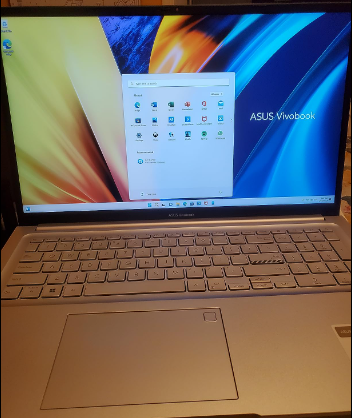
Core i3 1220P
16GB RAM DDR4
AMD Radeon RX Vega 10
1TB SSD
17.3” Full HD 4 way NanoEdge bezel display
4.62lbs
5 hours
WiFi 6 802.11AX
Reader Multi-format card reader (SD/SDHC/SDXC) Networking 1 x COMBO audio jack 1 x Type-C USB 3.0 (USB 3.1 Gen 1) 1 x USB 3.0 port(s) Type A 2 x USB 2.0 port(s) Type A 1 x HDMI 1 x micro SD card
This is the latest model of the 17 inch ASUS VivoBook and just like last year’s model, it still has ALL the features you want for a teaching laptop and only costs around 550 dollars.
Whereas the average 17 inch laptop with the same specs is over 650 dollars.
If that’s also out of your budget, don’t worry the next laptop is about 100 dollars cheaper. Let’s review this laptop first.
What’s so good about the ASUS VivoBook?
It’s the display. While it may not be rare in 2024 to find a 17 inch laptop with FHD resolution under 500 dollars, it’s somewhat rare to find the display with Anti-Glare screen (useful for reflections and illuminated areas) plus thin bezels (it makes the laptop look slightly bigger).
Ideally, you’d want QHD resolution to get a MUCH MUCH bigger screen area but that’s only found on laptops over 650 dollars. I’ll show you one of these soon.
Core i3 1220P:
Unlike most 17 inch laptops under 500, the ASUS VivoBook may not have the latest Core i3 but it’s still quiet recent. It’s the previous generation (the latest is the 13th). It is likely the ASUS VivoBook with the 13th generation Core i3 or Core i5 may be released this year soon. However, difference in performance is minimal between the two generations especially for everyday teaching tasks.
Another thing to keep in mind is that ideally you want a Core i5 however that raises the prise significantly. You can still get fast performance if you opt for the LATEST Core i3 CPUs or Ryzen 3 CPUs.
1TB SSD:
Most 17 inch laptops under 500 have 512GB at the most and many of them only have 256GB.
While those two capacities may be enough for MOST TEACHERS. In the most extreme situation, that is, a teacher who stores about 400 lectures recordings and plays several AAA games and a whole repository of mp3 files will need about 700GB. You’ll still have about 300GB left with 1TB.
16GB RAM:
It isn’t necessary to have 16GB RAM but it is a nice bonus. While 8GB RAM will suffice for most people. Why is 16GB helpful? Let’s say you have do some serious multitasking. You open a dozens of software simultaneously along with 50 web browsing tabs open. This is an extreme example. This will slightly lag with 8GB RAM but it will still be smooth with 16GB RAM.
Q: What about the CPU? Why not get a Core i7/Ryzen 7 or at least a Core i5?
I know it may seem cool to have the Core i7 or Ryzen 7sticker on your laptop.
But the reality is that it makes little difference for the kind of tasks you’re running. It’s not like you’re doing video or photo editing on a daily basis. Ryzen 7 and Core i7 CPUs are way too overkill even for serious multitasking.
As long as you pick a recent Core i3 or Ryzen 3 (released within the past 3 years) , you’ll never lack CPU power to do teaching tasks.
What’s the caveat of this laptop ?
It’s the display. The brightness levels onl reach 250 nits and this isn’t ideal say when you have a laptop right next to the window with the curtains open. It may be hard to distinguish what’s on the screen. A solution is to simply add a matte cover to your laptop to reduce reflections. If you work indoors mostly or you can afford to have your laptop away from the window then you don’t really need high brightness levels.
| ASUS VivoBook 17 | |
| PROS | CONS |
|
|
2. ASUS VivoBook 15”
Best Budget Laptop For Teachers
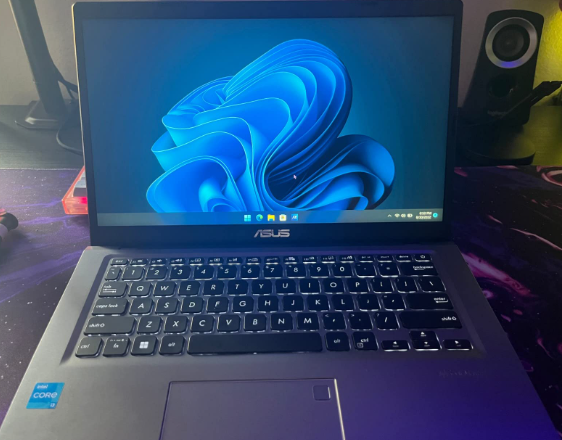 Intel i3-1215U
Intel i3-1215U
8GB RAM DDR4
Intel UHD
128GB SSD
15” full HD TN
5.57 lbs
7 hours
WiFi 5 802.11 AC
Reader Multi-format card reader (SD/SDHC/SDXC) Networking 1 x COMBO audio jack 1 x Type-C USB 3.0 (USB 3.1 Gen 1) 1 x USB 3.0 port(s) Type A 2 x USB 2.0 port(s) Type A 1 x HDMI 1 x micro SD card
This is also an ASUS VivoBook, it keeps the same design thus keyboard quality and even a very similar CPU but it’s much much much cheaper. It’s about 350 dollars which is 200 dollars cheaper than the ASUS VivoBook 17.
What’s the difference? What are the trade offs?
OK, you’re going to have to give up a lot of stuff but these are not crucial and you can “make do” without:
- WiFi 5: The ASUS VivoBook 17 has the latest WiFi protocol found on laptops. You will lose some internet speed IF you’re using a connection that’s being shared by hundreds of people. However, if your school has a WiFi Router or repeater in every room, it should be no problem and you should get the same speed.
- Display: This is a 17 inch laptop so you’re losing a significant amount of screen space. But the advantage is that this is much much more portable than the 17 inch laptop. Also there’s still plenty of space to work with say two windows next to each other and still visualize a large part of each window. This isn’t the case for 13” or even worse 11” laptops which you must stay away from.
-
128GB vs 1TB SSD: This laptop only comes with 128GB. If you’re using this laptop stricly for teaching purposes and do not plan on saving hundreds of zoom lectures/lecture videos on it, you should have plenty plenty of space for all the teaching software you’re going to use and all the pdfs documents (in the thousands) you need to store: LMS, classroom management software, office, zoom, etc.
- If you do run out of space, you can always upgrade this laptop. You can add an additional 2.5” SSD or HDD as shown below:
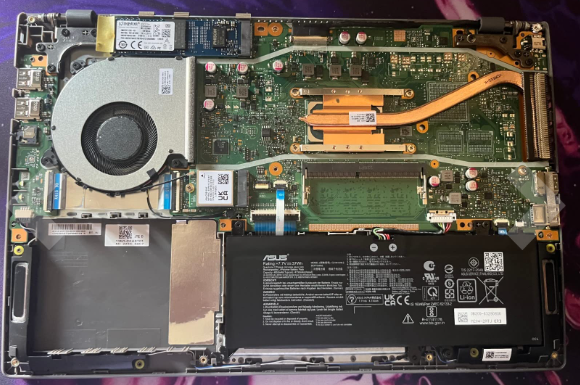
- If you do run out of space, you can always upgrade this laptop. You can add an additional 2.5” SSD or HDD as shown below:
8GB RAM vs 16GB RAM: This laptop only has 8GB RAM . 4GB RAM is soldered to the motherboard so you have to buy an additional 8GB or 16GB RAM to get 16+ GB of RAM like the ASUS VivoBook.
CPU: Core i3 1215U
The processor is still weaker than Core i5 and Ryzen 5 of equivalent generations but for teaching purposes it’s still enough. It’s still a multi-core CPU and has 6 cores so it can handle multitasking just as fine as a Core i5 or Core i7. In fact, performance wise is pretty much the same as the Core i3 1220P for everyday tasks with the additional bonus of consuming less power thus extending battery life.
Windows 11 in S Mode:
This laptop comes with Windows 11 in S mode by default which is a nerfed version of Windows that doesn’t let you install third party software that’s outside of their store among other limitations. It works fine for those that don’t need to install any specific/niche software.
You can switch out of S mode and install the full version of Windows we all know of by simply going to the Windows app store (the application is installed by default in every windows system) and typing Windows 11. The upgrade is free.
| ASUS VivoBook 17 | |
| PROS | CONS |
|
|
3. LG GRAM 17
Laptop For Teachers – Lightweight & Large Display
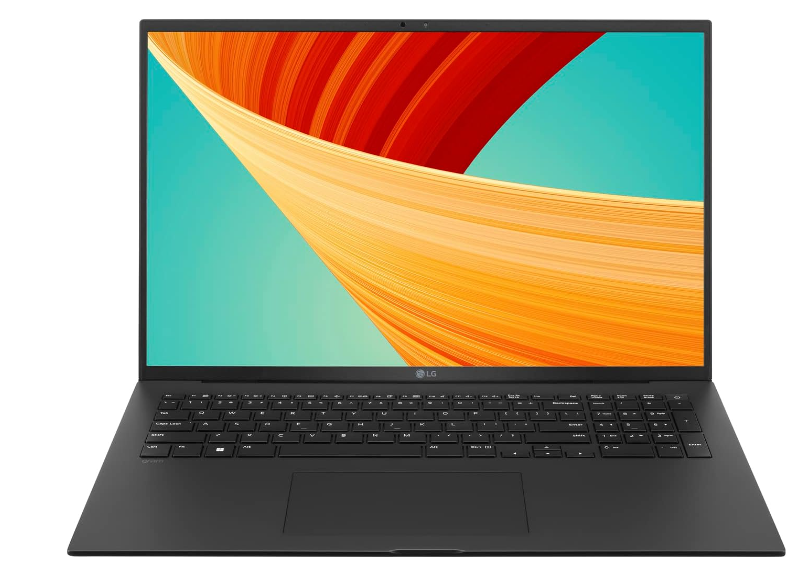
Core i7 13th
16GB
Intel UHD Graphics
512GB SSD
17” QHD Anti-Glare IPS 350 nits
2.51 lbs
10-12 hours
Wifi 6 802.11AX
10/100/1000 Gigabit Ethernet LAN (RJ-45 port), HD Webcam (1280 x 720), 1 – USB 3.1 Gen 1 Port, 2 – USB 2.0 Ports, 1 – HDMI Port with HDCP support
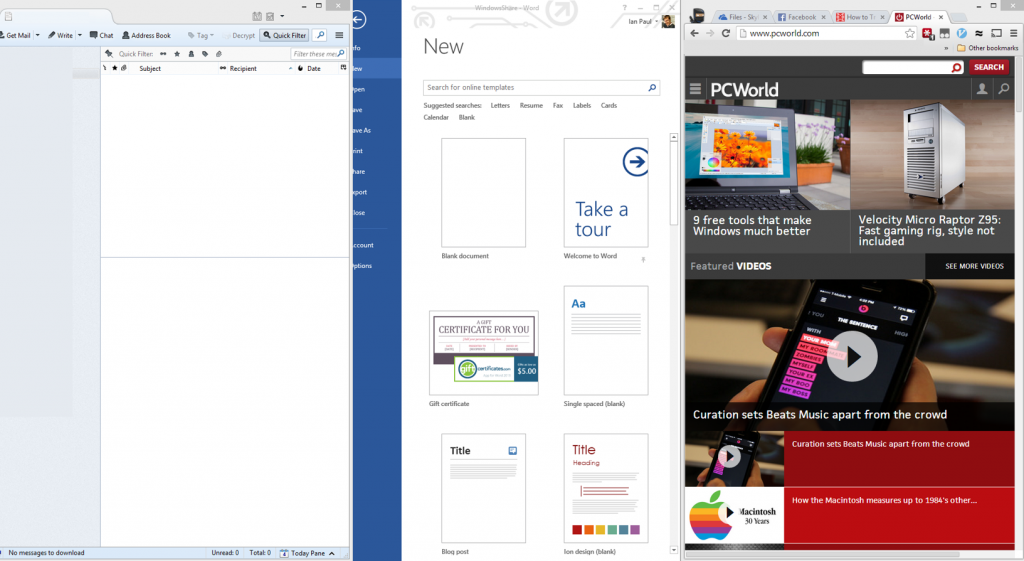
Weight & Design:
| LG Gram 17 | |
| PROS | CONS |
|
|
4. MacBook M3 Pro Chip
Best MacBook For Teachers
M3 12 Core CPU
18GB Unified Memory
18 Core GPU
512GB SSD
16.2” Liquid Retina 2234×3456
4.7lb
13 hours
If you got an iPhone or an iPad, then it goes without saying you’re probably thinking about buying a MacBook and that’s not a bad idea for teaching.
The problem is they’re very expensive right?
But there are ways to get the benefits of having a MacBook without having to pay more than a thousand dollars.
You can refurbished MacBooks. Of course if you can affor the newest model featured here, that’d be the best.
Why pay that much or even go as far as “risking” it buying used laptops?
First of all, refurbished laptops aren’t the same as ‘used’ laptops. They go through a quality control process to function like new laptops and they all come with a warranty. If you buy it off amazon, you’ll get a 90 day warranty.
Now why go so far for a MacBook?
Several reasons:
- All MacBook Pros & MacBook Airs are lightweight especially the recent ones.
- They have very long batteries (10h on average).
- System boot up is extremely fast
- MacBook Pros (Old or New) and the latest MacBook Airs have Retina resolution (this is as high as QHD resolution almost x2 the resolution of FHD)
- Best trackpads on the market whereas buying a mouse would be a must if you buy a windows laptop.
- Best keyboards on the market: slow travel and very responsive, almost noiseless.
Software Compatibility: OSX & Teaching Software
Pretty much every software that’s mainstream like Office, Zoom, Discord, etc, all have Mac Version. There’s no need to worry about compatibility for those. However, third party software especially those given by your institution MAY have some issues though not always as MacBooks are also mainstream.
If a software compatibility arises then you can always launch Bootcamp with the older pre 2020 (non M1, M2 , M3 MacBooks) to run Windows 11 and then launch your ‘Windows’ software whenever the need arises.
If you’re buying the newer models, you can use Parallels and run a virtual machine for Windows 11.
| MacBook Pro 16” | |
| PROS | CONS |
|
|
5. Lenovo IdeaPad 3
Best Cheap Laptop For Teachers
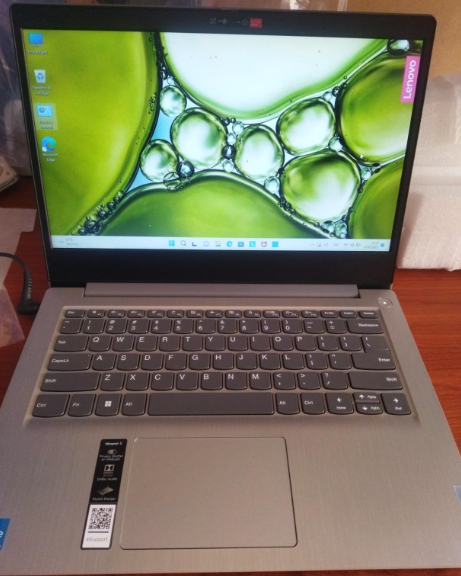
Intel Core i3-1115G4
8GB DDR4 RAM
Intel UHD Graphics
128GB SSD
14” FHD
3.3 lbs
7 hours
WiFi 5 802.11ac
3 USB-A ports, 1 USB 2.0 and 2 USB 3.0, there is no USB-C
This is the cheapest option on the list. Usually around 260 dollars!
Most of the useful ‘extra’ features are lost with the exception of the display. You can work with this laptop but it’s just going to be a regular laptop not a laptop tailored for teaching.
The main two drawbacks with this laptop are the display which is smaller (14”) and the keyboard which doesn’t have a numerical keypad.
Keyboard: Most of the laptops we went over so far have a numerical keypad (with the exception of the MacBook) which is really extremely useful if you want to be super productive when crunching numbers on sheets. The solution for those ocassion where you just to crunch numbers is buying an external numerical keypad which you can find on amzon for 10 bucks.
Display: Luckily, it still has a FHD display and it’s not a 13” nor an 11′ laptop. 14” is still pretty decent with FHD resolution, there’s plenty of space to at least multitask with two windows next to each other although you won’t have the same view (you won’t get the bigger picture of each window).
RAM: Also unlike most laptops under 300, this one has 8GB RAM. So you won’t need to upgrade RAM to have a fast performance when multitasking. Of course, you can do the upgrade to 16GB if you want to throw in some extreme multitasking and still have very fast performance (the 11th gen CPU can handle multitasking for basic software & tasks just as well as the latest generations).
Storage: This is small drawback. Sure 128GB is small and half of it will be gone with just Windows 11 being installed but unless you MUST store a hundred video lectures, it should be plenty for every other file & software. If it runs out of space, you can do the upgrade later.
If things are slow after you install Windows 10 Home, add 4 GB RAM. If you run out space, add an HDD.
| Lenovo Ideapad 3 | |
| PROS | CONS |
|
|
How To Buy The Best Laptop For Teachers
I’ll explain a bit of hardware specs for those that are not acquianted and also talk about why should choose the following specs. I’ll give you a few tips on how to find the most difficult features on a laptop too.
We’ll go in order of priority, starting with the most important one:
1) RAM (Memory)
RAM basically means memory. The more RAM you have the more ‘programs’ and ‘data’ you can have running in the background.
That’s of course if you have a CPU and SSD but most CPUs are fast anyways and most laptops have an SSD so RAM becomes the single most important hardware spec.
If you get enough RAM , everything will be fast and you won’t have to worry about closing or opening programs for your computer to keep running fast and keep you productive.
4GB: This is way too low and you’ll find on very few laptops mostly those under 300 dollars and old MacBooks. It works well if you are not running Windows 11 (or any of the full versions of Windows). What I mean is if a laptop has 4GB RAM and it’s running OSX (Apple) or Chrome OS (ChromeBook) or Windows in S mode (nerfed version of Windows), it will be fine.
8GB: This is the BARE bone minimum and in fact if you’re all running everyday tasks and web browsing. It’s going to be extremely rare for you to run out of memory, you’ll always be productive.
16GB: This is the limit and this is as much as you’re going to need. It may not be that helpful because you are unlikely to run a number of programs that will deplete 8GB RAM but nonetheless it’s still nice to have. You can have 100 web tabs open with all the teahcing software in the background (as if that ever happens) and your computer will still be fast.
It’s not wise to buy a laptop with 16GB RAM on-board (unless it’s cheap) so most of the time (because laptops with 16GB RAM on-board are usually expensive) doing the upgrade from 8GB — > 16GB is the way to go. The steps are easy , as shown here, and if you can’t do it, just take it to the school computer guy.
2) Display
This is without question the second most important (if not the first because most laptops have 8GB RAM anyways). You want to maximize screen space as much as possible:
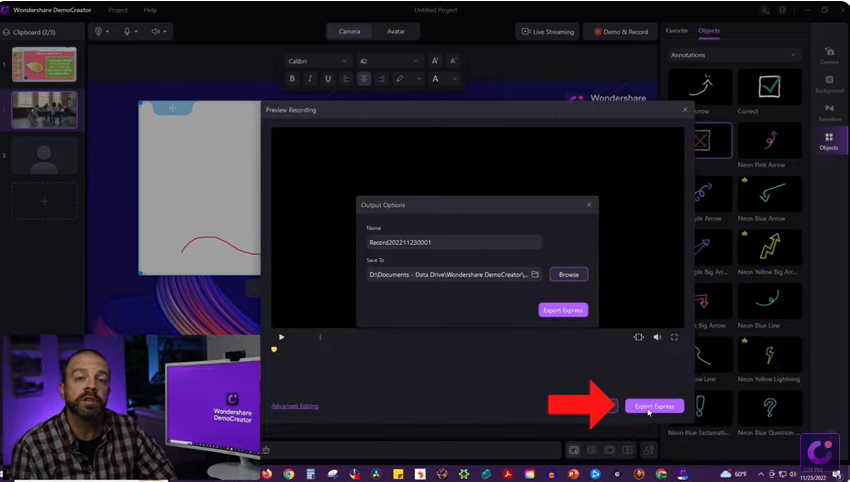
The more space you have the easier it is to multitask and the more stuff you can see at once too.
A) Display Size
The first way to do this is by choosing a big display. You must avoid 11 and 13” displays UNLESS you need something portable.
11” and below:
Obviously have to be avoided.
It’s not just the size of the screen that takes a toll but also the size of the keyboard which makes it super hard to type. These may be good if you’re something like a PE teacher because they’re very portable and you can take them outside for which case you should really consider a Surface Pro or an iPad.
13”: This size OKAY but not ideal, you want to choose this one IF you MUST get something portable (~3lb or less). If you get a 13” display with FHD resolution (we’ll talk about that later) you’ll offset the lack of screen space.
15-17”: 15” is the sweet spot. 17” is pushing it but if you’re a guy and can afford to carry a heavy and big laptop on your suitcase. More power to you, if this is mostly staying at home, then even better. 17” is the way to go.
B) Resolution
High resolution means high number of pixels. The more pixels you have, the higher the number of objects your computer can render on the screen. This means being able to reduce the size of objects (toolbars, buttons, fonts) while still making them distinguishible.
TL;DR: High resolution gives you more pixels which means more screen space.
If you add a 15” or 17” on top of a high resolution display, you’ll get an insane amount of screen space that will closely resemble the space you have available on a desktop monitor (23”).
What’s high resolution? QHD (1440p or 2560×1660) or FHD ( 1920 x 1080p).
What’s low resolution? Anything below FHD. For example HD (720p) or HD+ (900p)
C) Bezels
Bezels are the material surrounding a laptop’s display. It’s usually thick but some laptops have THIN bezels and very few laptops have VERY THIN BEZELS. Obviously, that means you can see MORE of the display. Thus a 17” display with thin bezels will feel like an 18” display.
A 15” display will feel like a 16” display if it has thin bezels.
D) Extra
Brightness leves (nits): They’re somewhat useful if your laptop is sititng somewhere near a Windows or a place where there’s strong sunligiht coming in. High brightness can still make the display contents visible despite the bright background.
For this to happen, you need at least 300-350 nits. Most laptops have 250-300 and some premium laptops can have up to 500 nits.
Finish (Matte vs Glossy displays)
Most laptops now have IPS panels (as opposed to TN) and within IPS panels there are two types of finish: matte and glossy.
Glossy have more vibrant colors and are really good for watching movies.
Matte finish are more useful for a professional settings:
- Reduces the intensity of the light
- Prevents glares
- Makes it easier to use in bright background (less reflections)
- Since it reduces the amount of what’s reflectedon the screen, there’s a lower chance for you to get distracted too.
3) Keyboard
Since you’re going to be typing your eyes out on this thing, you need a GOOD keyboard to keep a fast workflow. Just like most modern laptops have decent CPUs, most have decent keyboards but very few have outstanding keyboards. Follow this tips and you’ll increase your chances of finding a good keyboard without having to test it out yourself:
- MacBooks have the best keyboards. Can’t afford the new ones? Trying buying refurbished or an older model.
-
Can’t use OSX due to software compatibility? No problem.
- Great keyboards are common on 15” and 17” laptops.
- Premium ultrabooks prioritize on designing a good on-board keyboard ( ASUS ZenBook, Dell XPS, HP Envy, Surface Devices, etc).
- If spending less than 600 bucks, the thicker the laptop the higher the chances the keyboard has good travel and thus it’s very responsive.
To be sure , read the reviews written by users on the website you’re buying a laptop from. If there aren’t reviews for the laptop you want to buy on a particular site, then try typing the model’s name on the amazon search bar and read reviews.
4) CPU
There are basically two companies monopolizing the laptop market for CPUs so your choices are down to two: either Intel or AMD.
Either works fine as long as you avoid:
- Obsolete CPUs (released several years ago).
- CPUs that are too expensive.
- CPUs that are unnecessarily powerful.
- CPUs that are too weak (designed mostly for tablets but still used on laptops).
Follow the next guideline and you’ll be alrigiht:
- First, only choose CPUs that have the letter U, G, P, E at the end. (Designed for light tasks – teaching)
- Avoid CPUs that have the letter H anywhere even if it says HX HS. (These are designed for very heavy apps).
- Avoid Ryzen 7 or Core i7 CPUs unless they’re cheap (Theyre too fast and expensive)
- Avoid any CPU that doesn’t have the word Ryzen or Intel Core. Ex: Intel Celeron, Pentium, etc.
- Avoid old generations. For example, anything before the 8th generation for Intel is too slow. Ex: Core i5 7110U. For Ryzen CPUs , anything that doesn’t say Ryzen is old.
For example all of these are good:
| Intel Core |
| i3 1115G4 |
| i3 1215U |
| i3 1305U |
| i5 1135G7 |
| i5 1230U |
| i5 1345U |
| AMD |
| Ryzen 3 5300U |
| Ryzen 3 7320U |
| Ryzen 5 5500U |
| Ryzen 5 7520U |
STEM Teachers: If you’re a STEM teacher who has to run 3D software for simulations and so on, you can benefit a lot from Ryzen 7 and Core i7 CPUs especially (though not required) those with dedicated graphics.
5) WiFi Card & Protocol
Obviously all laptops have a Wifi Card.
Since people tend to overlook anything outside the CPU & RAM, manufacturers try to sneak in slightly older WiFi Cards which are not bad by themselves but you could get better reception with the modern ones.
The latest WiFi Protocol found on laptops is WiFi 6. The one before that is WiFi AC (or WiFi 5), let’s talk about each:
WiFi AC or 802.11 AC: no longer the most common but it’s still somewhat common especially on budget machines. They work quiet well if you’re using your very own WiFi or a WiFi that has not many people connected to it.
WiFi 6 or 802.11 AX: These are extremely useful if you’re sharing a connection with hundreds of people. You will get better reception thus more bandwidth as opposed to WiFi 5 (AC).
If you’re teaching from home, you can pick any and still be fine.
6) Storage
Type: SSD vs HDD
SSDs (Solid State Drives ) are several times faster than HDDs and they make the whole system start up in seconds. That is, it will take literally seconds, to get your laptop ready to go from the moment you turn it on.
It also speeds up opening/closing files/programs. Virtually all laptops released within the past 5 years have an SSD now. You don’t have to watch out for HDDs unless you’re buying old refurbished laptops.
Capacity
Unless you’re an avid gamer too you aren’t likely to worry about storage capacity.
Let’s run some numbers:
Windows 10 Home (not S mode) :64GB
Any MS Office (latest or not they all take up the same space) :5GB
Video + Photo Editor :Adobe Premiere (8GB) + Photoshop (16GB)
Zoom/Discord/Video players and other teaching software:10-15GB
1000 Books:20 GB
Videos/lectures: 1GB per 1h video. 100 videos = 100 GB.
In the worst case scenario, you’ll need ~ 200GB. Most laptops have 256GB (those with Windows 11).
What if you store a lot videos? or Play STEAM games?:
Assuming you’ve got 300 zoom videos of 1h each. You’ll need an extra 300GB…thus you’ll need 512GB.
If you play games on top of that, you’ll need:
- Size of the average AAA Game like FortNite/WoW/MC ~50GB. 150GB for 3 games.
If you listen to lots of music:
- x1000 mp3 songs (3.5MB each) ~ 3.5Gigs
Making a total of ~700GB.
In the most extreme scenario, you’ll need 1TB of storage.
Upgrading storage
If you buy a laptop with 256GB or 512GB and you feel you need more space, you can always upgrade storage. It is an easy but long process. I have written a guide on how to do it here. You don’t have to do it right after buying laptop you can just wait and see if you need more space.
7) Operating System
OSX(Mac) vs Windows
Remote desktop apps, Office and the usual stuff are all available on both Windows and Macs.
OSX is only going to be a problem if you’re using software made by your institution and said software only runs on Windows.
Chrome/Windows 10 S mode:
You can “MAKE DO” with these Operating systems provided you only use the basic stuff and most commonly used software on the full version of Windows since such software have a version that runs on these. For example, excel & zoom are all there.
However, LMS software, information delivery & collection software & classroom management software aren’t likely to have a version that runs on these.
8) Ports
You don’t have to check every laptop to see if they have ports for projectors or external displays. All modern laptops have at least TWO USB ports (worst case scenario one) , a USB-3 ( thunderbolt port ) , an HDMI port (to attach external monitors & projectors) .
Projectors:most have an HDMI some have a VGA port if that’s the case then you’ll have to buy an adaptor because virtually all modern laptops lack a VGA port.
Comments?
If you have any questions, questions or any suggestions. Please leave a comment below. Your input is taken seriously in our posts and will also be used for future updates.
Author Profile

- I am physicist and electrical engineer. My knowledge in computer software and hardware stems for my years spent doing research in optics and photonics devices and running simulations through various programming languages. My goal was to work for the quantum computing research team at IBM but Im now working with Astrophysical Simulations through Python. Most of the science related posts are written by me, the rest have different authors but I edited the final versions to fit the site's format.
Latest entries
-
 Laptops2024.07.09Laptop Storage Type Guide (PCIe NVMe, SATA III, HDD, eMMC)
Laptops2024.07.09Laptop Storage Type Guide (PCIe NVMe, SATA III, HDD, eMMC)
-
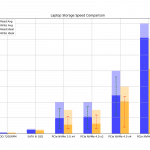 Laptops2024.07.02Laptop Storage Speed Comparison (PCie NVMe 5.0, 4.0, 3.0, SATA III)
Laptops2024.07.02Laptop Storage Speed Comparison (PCie NVMe 5.0, 4.0, 3.0, SATA III)
-
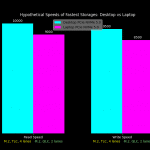 Hardware Guide2024.06.29Desktop Storage vs Laptop Storage Speed Performance Comparison
Hardware Guide2024.06.29Desktop Storage vs Laptop Storage Speed Performance Comparison
-
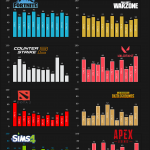 Hardware Guide2024.06.23Single-Thread vs Multi-thread CPU For Gaming (List & Benchmarks)
Hardware Guide2024.06.23Single-Thread vs Multi-thread CPU For Gaming (List & Benchmarks)

